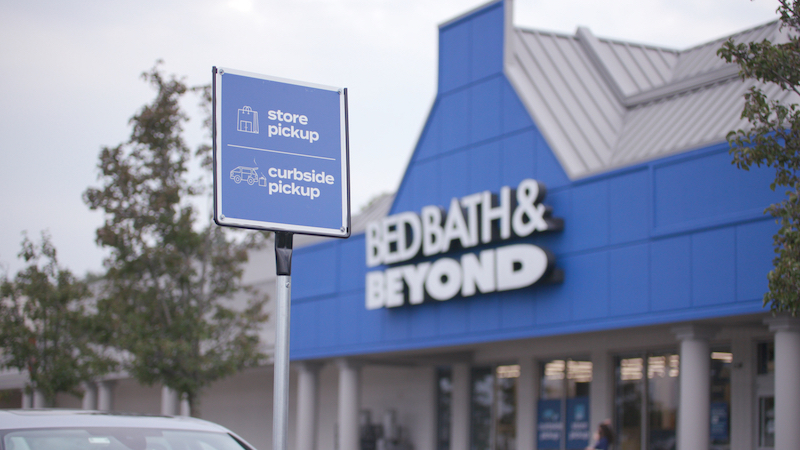Retail bankruptcies are opening ripe real estate opportunities for competitors

When one bankrupt retailer moves out of its lease, another retailer is looking to move in.
That’s the case with Bed Bath & Beyond this year when it announced that it was going out of business and closing its remaining 360 namesake and 120 Buy Buy Baby stores. Other retailers like Burlington, Macy’s and Michael’s quickly jumped in to grab Bed Bath & Beyond’s prime real estate locations. But Bed Bath & Beyond isn’t the only one: Other bankrupt retailers like Party City and Rite Aid are also in the process of handing off their stores.
It’s no surprise that empty commercial real estate space, particularly those that come from big-box retailers, are in high demand. Compared to a new real estate space, the stores formerly owned by bankrupt retailers offer historical foot traffic data. After a number of physical retailers filed for Chapter 11 this year, the floodgates of real estate opportunities have opened up for fast-growing retailers looking to expand into new markets.
Ethan Chernofsky, svp of marketing at Placer.ai, said that getting great retail spaces is competitive because not a lot of new spaces are being built and more retailers are vying for the same spots. “You have more retailers looking to have space,” Chernofsky said. Retail Bankruptcies like Bed Bath & Beyond “frees up a lot of space all at one time, which is a very exciting opportunity for brick-and-mortar retailers.”
Indeed, taking over these leases could help retailers enter new neighborhoods and reach new demographics.
Rite Aid filed for Chapter 11 bankruptcy protection in October after experiencing significant losses. The drug store intends to sell 180 Rite Aid and Bartell Drug leases in states like California, New Jersey and Pennsylvania, among others. Party City, on the other hand, started auctioning off nine of its leases in April and is offloading from as many 28 store locations as part of its bankruptcy filing. The bidders of these spaces have yet to be publicly disclosed.
This isn’t a new phenomenon. When Sports Authority and Toys R Us filed for bankruptcy a few years ago, retailers also started to take over their spaces. When Toys R Us went dark in 2018, over 700 stores were left empty. Burlington took over Toys R Us stores in markets like California and New Jersey. The off-pricer also took over 30 different Sports Authority locations when it filed for Chapter 11 in 2016.
History is repeating itself. Burlington is taking advantage of the real estate left behind by Bed Bath & Beyond by taking over 50 of its locations for $13.53 million. Meanwhile, Michael’s is taking on nine leases for $2.55 million and Macy’s is taking over a location in Winter Park, Florida for $1.2 million.
“We have a very strong real estate team that has a lot of experience dealing with retail bankruptcies,” Burlington CEO Michael O’Sullivan said during a call with analysts. “Many of our most successful and productive stores today were once upon a time Circuit City, Toys R Us, Sports Authority, Linens ’N Things.”
If landlords are eager to fill up these spaces, retailers could also benefit from more favorable lease terms, said Adam Robbins, a strategic real estate advisor at Real Estate Bees and president of asset management firm ARC Equities, LLC.
“It’s very market driven,” Robbins said. “The smaller operators are anxious to backfill their properties. They’ll probably be willing to negotiate.” He added that larger operators can likely afford to wait longer for the right tenant.
Brad Jashinsky, director analyst at research firm Gartner’s marketing practice, said that a retailer like Bed Bath & Beyond likely invested a significant amount of their budgets on researching which markets their products would appeal to.
“The challenge with a new location, especially if it’s brand new, is you don’t have historical traffic data so there are more unknowns there,” Jashinsky said. “You have a nice combination of less expensive opportunities, combined with past evidence of store traffic and having an idea of what traffic patterns look like.”
However, he said, these retailers looking to snatch these real estate spaces still need to be strategic about their expansion strategy. He warned that expanding too much, too quickly could end up hurting retailers.
That doesn’t seem to be a concern for Burlington. O’Sullivan said that retail bankruptcies would give the company an opportunity to open more stores in 2024 and 2025. “We think these bankruptcies are likely to have a significant impact on the availability of attractive new store locations,” O’Sullivan said in an earnings call. “We’re confident that these bankruptcies will strengthen our new store pipeline.”

